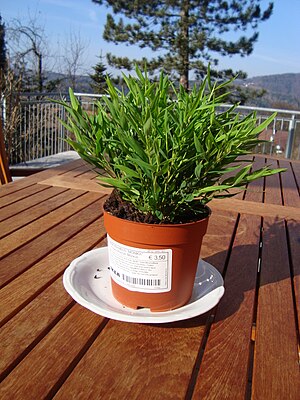Indoor bamboo
| Indoor bamboo | ||||||||||||
|---|---|---|---|---|---|---|---|---|---|---|---|---|

Young indoor bamboo ( Pogonatherum paniceum ) as a potted plant |
||||||||||||
| Systematics | ||||||||||||
|
||||||||||||
| Scientific name | ||||||||||||
| Pogonatherum paniceum | ||||||||||||
| ( Lam. ) Hack. |
The indoor bamboo ( Pogonatherum paniceum ), also known as Seychelles grass , bonsai bamboo or bamboo grass , is a type of plant from the genus Pogonatherum within the sweet grass family (Poaceae). Despite the name indoor bamboo , it is not a type of bamboo .
description
Vegetative characteristics
The room bamboo is a perennial herbaceous plant and forms mats. The stalks stand upright at their base and are 30 to 60 centimeters high with a diameter of 1 to 2 millimeters. They are hard and unbranched in the lower area, densely branched tufts are formed in the upper area. The leaf sheaths are bald or finely haired, the ligula has a membranous border and is ciliate. The leaf blades are stiff, somewhat rough and pointed, 1.5 to 5.5 inches long and 0.15 to 0.4 inches wide.
Generative characteristics
The 1.3 to 3 centimeters long, yellowish, racemose inflorescence consists of pairs of one sessile and one stemmed spikelet . Each spikelet contains two flowers , a lower sterile and an upper fertile . The sessile spikelets are 2.3 to 3 millimeters in size. The lower glume is coarse or finely hairy on the back, the tip is ciliate with hairs 0.5 to 1 millimeter long. The upper glume carries an awn from 1.3 to 2 centimeters. The lemma and palea are shorter than the lower glume, the upper lemma carries an awn about 1.5 to 1.8 centimeters long. In the case of the two stamens , the anthers are about 1.8 millimeters long. The pedunculated spikelet is similar to the sessile, only slightly smaller and the lower glume lacks the awn.
The number of chromosomes is 2n = 20 or 40.
Distribution and location requirements
Pogonatherum paniceum is common in Afghanistan , Pakistan , India , China , Nepal , Bhutan , Thailand , Laos , Vietnam , Malaysia and Myanmar . It is also found in Saudi Arabia , Socotra , Borneo , New Guinea and the Lesser Sunda Islands . Pogonatherum paniceum thrives at altitudes of 100 to 2300 meters on mountain slopes, sandy and rocky subsoil, on roads or rivers. The well-developed roots give Pogonatherum paniceum a good hold on rock and enable it to survive on dry soils and rocky subsoil.
In the Red List of the IUCN is Pogonatherum paniceum classified as endangered ( "Least Concern"). Pogonatherum paniceum is widespread and common.
Systematics
Pogonatherum paniceum belongs to the genus Pogonatherum P.Beauv. in the subfamily Panicoideae within the sweet grass family (Poaceae). The room bamboo is therefore not a bamboo (subfamily Bambusoideae ).
Taxonomy
The species was first described by Jean-Baptiste de Lamarck in 1785 under the name Saccharum paniceum ( Basionym ) and assigned to the same genus as sugar cane ( Saccharum officinarum ). Palisot de Beauvois assigned it in 1812 as Pogonatherum saccharoideum of the genus Pogonatherum . In 1906 the name was corrected by the Austrian botanist Eduard Hackel in Pogonatherum paniceum .
Other synonyms for Pogonatherum paniceum (Lam.) Hack. : Tripsacum paniceum (Lam.) Raspail , Perotis polystachya Willd. , Pogonatherum polystachyum (Willd.) Roem. & Schult. , Pollinia polystachya (Willd.) Spreng. Handle , saccharum panicosum . , Pogonatherum santapaui Sur .
use
The bamboo grass is used as an ornamental and houseplant. It must not dry out and needs a bright location.
swell
literature
- Shou-liang Chen, Sylvia M. Phillips: Pogonatherum. : Pogonatherum paniceum , p. 592 - the same text online as the printed work , In: Wu Zheng-yi, Peter H. Raven, Deyuan Hong (ed.): Flora of China. Volume 22: Poaceae. Science Press and Missouri Botanical Garden Press, Beijing and St. Louis 2006, ISBN 1-930723-50-4 .
- H. Heitz, C. Recht, E. Markmann: Indoor plants . Gräfe and Unzer, Munich 1995, ISBN 3-7742-2136-7 , pp. 149 .
Individual evidence
- ^ A b c Shou-liang Chen, Sylvia M. Phillips: Pogonatherum. : Pogonatherum paniceum , p. 592 - the same text online as the printed work , In: Wu Zheng-yi, Peter H. Raven, Deyuan Hong (ed.): Flora of China. Volume 22: Poaceae. Science Press and Missouri Botanical Garden Press, Beijing and St. Louis 2006, ISBN 1-930723-50-4 .
- ↑ a b W.D. Clayton, KT Harman, H. Williamson: Pogonatherum paniceum. In: GrassBase - The Online World Grass Flora. Royal Botanic Gardens, Kew, January 28, 2008, accessed March 3, 2009 .
- ^ Pogonatherum paniceum at Tropicos.org. In: IPCN Chromosome Reports . Missouri Botanical Garden, St. Louis
- ↑ a b c Rafaël Govaerts (Ed.): Pogonatherum paniceum. In: World Checklist of Selected Plant Families (WCSP) - The Board of Trustees of the Royal Botanic Gardens, Kew . Retrieved September 10, 2018.
- ↑ a b Pogonatherum paniceum in the IUCN Red List of Threatened Species 2013.1. Posted by: S. Mani, 2011. Retrieved September 2, 2013.
- ^ A b Pogonatherum paniceum in the Germplasm Resources Information Network (GRIN), USDA , ARS , National Genetic Resources Program. National Germplasm Resources Laboratory, Beltsville, Maryland. Retrieved January 8, 2003.
- ↑ Saccharum paniceum Lam. In: Germplasm Resources Information Network (GRIN). United States Department of Agriculture, January 8, 2003, accessed March 4, 2009 .
- ↑ Pogonatherum saccharoideum P. Beauv. In: Germplasm Resources Information Network (GRIN). United States Department of Agriculture, January 8, 2003, accessed March 4, 2009 .
- ↑ H. Heitz, C. Recht, E. Markmann: Houseplants . Gräfe and Unzer, Munich 1995, ISBN 3-7742-2136-7 , pp. 149 .
